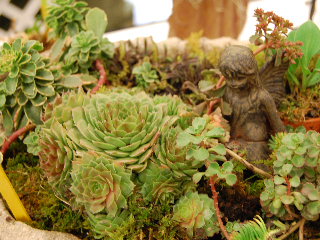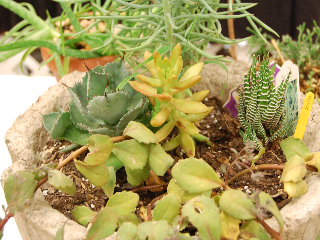
Succulents are plants that have evolved to survive in areas and times of little rainfall. Their survival is based on their ability to store moisture in their leaves, stems, or roots.
Succulents appear in a wide variety of shapes, sizes, colors, and textures in the plant world from large trees to tiny cacti.
For purposes of our discussion in this website, we will take a broad overview of succulents and consider how these plants might fit into your gardening plans, particularly as welcome additions to your family of houseplants.
Dish gardens are a popular way to display succulents indoors—from very small pots that hold only one little cactus to large circular or rectangular bowls and pots that sometimes contain a diverse assortment of succulents. Oftentimes the containers themselves are just as much conversation starters as are the unusually shaped and colorful succulents that they contain.
Most garden centers (and lots of other retail stores) offer ready-made tabletop succulent gardens for sale. This is a good way to get started learning about these unusual plants.
Or, it’s not that difficult to create your own succulent dish garden at home. Just purchase a few (or quite a few!) succulents and select whatever distinctive container you choose in which to establish your garden.
Be sure the potting mix is very loose and well drained. Add vermiculite, perlite, or clean sand to the mix to allow maximum aeration and good drainage. Succulents are very picky about not having their roots in standing water, which can lead to deterioration and rotting of the roots and ultimately to the death of the plant.
And, speaking of water, succulents do require normal to light waterings, particularly during the warm summer months of a regular growing season. Allow the soil mixture to dry out between waterings. Light feedings of a specialized plant food for succulents or cactus will also be beneficial to your plants during this time of active growth.

Slack off greatly on watering (and no fertilizing) during cooler dormant times of no growth.
In terms of light requirements, succulents prefer a bright location such as a windowsill. But take care not to allow too much direct sun on the leaves, as this can cause them to burn.
Some of the more popular plants you might want to consider for your succulent dish garden are kalanchoe, aloe, cactus, and jade.
Also read:
Jade--A Perfect Houseplant
Choose a nice mixture of textures, colors, and shapes in putting your varieties together.
Also, some of these succulents make great houseplants on their own—one plant per container. I’ve seen enormous old jade plants with woody stems that have attained unbelievable size through careful nurturing over a period of many years. The same is true of many well-tended Christmas cacti and other plants. Also read:
Christmas Cactus--Poinsettias Pretty Pal
Some gardeners like to maintain a potted Aloe vera plant so they can obtain juice from the leaves to be used in the treatment of skin burns and irritations.
Whatever plants you choose and for whatever reasons, succulents can add a whole new dimension to your collection of unusual and distinctive houseplants.
 Succulents are plants that have evolved to survive in areas and times of little rainfall. Their survival is based on their ability to store moisture in their leaves, stems, or roots.
Succulents are plants that have evolved to survive in areas and times of little rainfall. Their survival is based on their ability to store moisture in their leaves, stems, or roots.
 Slack off greatly on watering (and no fertilizing) during cooler dormant times of no growth.
Slack off greatly on watering (and no fertilizing) during cooler dormant times of no growth.